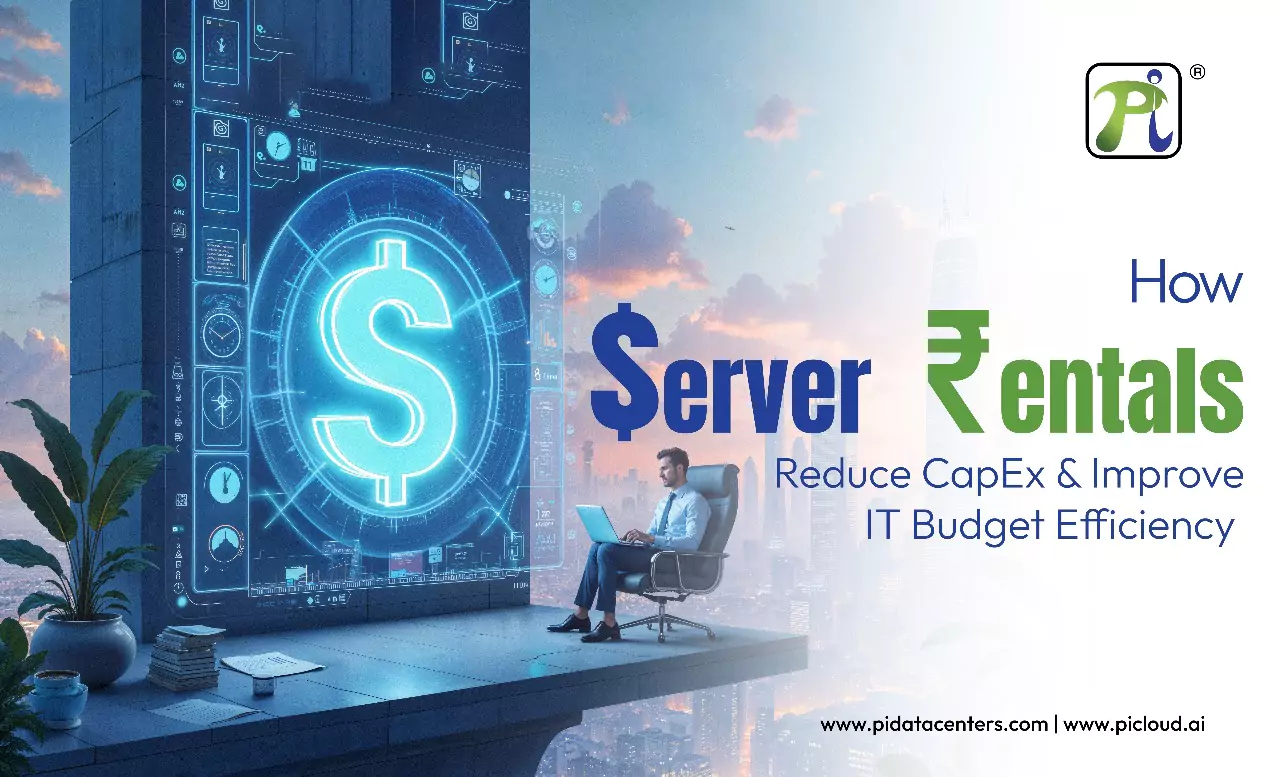We Will Get Back To You As Soon As Possible


Server rentals are becoming an essential part of IT infrastructure strategies, with the global server market projected to reach $317.55 billion by 2037, growing at a steady 8.9% CAGR. This growth highlights a major shift among businesses prioritizing cost-effective, scalable solutions to meet evolving technological demands without the weight of high upfront investments. Traditional models of significant heavy capital investment in IT hardware are giving way to more flexible options in a corporate environment where agility, efficiency, and financial restraint rule. Renting servers gives companies access to high-performance infrastructure without committing large capital expenditures (CapEx) or stressing asset depreciation. Modern companies depend on a knowledge of how server rentals lower CapEx and improve IT budget effectiveness. Companies can maximize their IT budgets, improve cash flow management, and concentrate financial resources on central business expansion by moving from big, upfront capital investments to predictable operating expenses.
Businesses sometimes divide spending into two main categories when designing IT infrastructure: operational expenditure (OpEx) and capital expenditure (CapEx). Long-term company planning and efficient IT cost control depend on an awareness of the differences between these two financial models.
Capital Expenditure (CapEx) in the context of IT infrastructure refers to the funds a business allocates to acquire, upgrade, or maintain long-term physical assets essential for its operations. These assets typically include servers, storage systems, networking equipment, and data centers. Such investments are capitalized on the company's balance sheet and depreciated over the asset's useful life, reflecting their long-term value to the organization.
For instance, when a company purchases new servers or constructs a data center, these are considered CapEx investments. While they offer benefits like asset ownership and control, they also require significant upfront capital and ongoing maintenance costs. Moreover, with the rapid pace of technological advancements, there's a risk of these assets becoming obsolete, necessitating further investments.
Given these challenges, many businesses are transitioning to models that favor operational expenditures (OpEx), such as renting IT infrastructure. This approach allows companies to access the latest technology without the substantial initial outlay, offering flexibility and scalability to adapt to changing business needs.
Operational Expenditure (OpEx) in IT infrastructure refers to the ongoing costs associated with the day-to-day operation and maintenance of technology systems and services. Unlike Capital Expenditure (CapEx), which involves significant upfront investments in physical assets like servers or data centers, OpEx encompasses recurring expenses such as leasing equipment, subscribing to cloud services, and outsourcing IT support.
Adopting an OpEx model offers several advantages for businesses:
For example, instead of purchasing servers outright (a CapEx), a company might opt to rent servers or utilize cloud-based solutions, treating these as OpEx. This approach allows businesses to remain agile, respond quickly to market changes, and focus resources on core activities rather than infrastructure management.
Modern businesses are increasingly moving away from CapEx-heavy IT strategies toward more OpEx-focused models. This shift is driven by the need for:
Choosing OpEx-based solutions like server rentals enables companies to stay competitive, responsive, and efficient in a rapidly evolving digital landscape.
| Feature | CapEx | OpEx |
|---|---|---|
| Nature of Spend | Large, upfront investment | Regular, ongoing expenses |
| Ownership | Asset owned by the business | Service or asset is rented/leased |
| Financial Impact | Impacts balance sheet; depreciated over time | Impacts profit and loss statement immediately |
| Flexibility | Low flexibility; asset tied to business | High flexibility; resources can be scaled easily |
| Examples in IT | Buying servers, building data centers | Renting servers, using cloud services |
Strategically switching from CapEx to OpEx models will help companies not only lower financial risk but also increase IT agility and match their infrastructure spending to current operational requirements.
Often referred to as IT infrastructure rental or server leasing, server rentals give companies access to potent server hardware without having to buy it straight-forward. Organizations can lease or rent servers for a designated period, paying a monthly or quarterly fee depending on use and service level agreements (SLAs), instead of devoting large capital to purchase physical servers.
This approach helps companies to enjoy excellent performance infrastructure with much less financial risk, maintenance overhead, or concerns about technology becoming outdated. Without the complexity related with ownership, rental servers for companies offer flexibility, scalability, and access to enterprise-grade technology.
Usually customizable, server rental services let companies select setups fit for their networking, storage, and processing needs. Many times offering support services including installation, monitoring, security, and maintenance, providers help companies to concentrate on primary operations instead of handling IT hardware.
There are several types of server rental options available, catering to diverse business needs:
Each server rental model comes with its own advantages, allowing organizations to align their IT infrastructure closely with performance needs and financial strategies.
The trend toward server leasing advantages is growing across multiple sectors as companies seek flexibility and operational efficiency:
As digital transformation accelerates, industries recognize that rental servers for businesses provide a competitive edge by offering the right combination of flexibility, scalability, and cost efficiency.
The possibility to drastically reduce capital expenses is one of the most convincing reasons companies choose server rentals. Historically, creating an in-house IT infrastructure required significant upfront investments in hardware, setup, and maintenance. Smart financial models provided by server rentals help companies better control budgets and change with the times in terms of technology requirements.
Here's how server rentals reduce CapEx and enhance financial agility:
Owning IT infrastructure demands significant capital outlay from purchasing servers, storage devices, and networking equipment to setting up physical spaces and cooling systems. With server rentals, businesses eliminate these heavy initial expenses. Instead of tying up capital in depreciating assets, companies can redirect those funds toward strategic initiatives like product development, marketing, or workforce expansion. By avoiding large purchases, businesses can also preserve credit lines and improve overall cash flow, which is critical for startups and growing enterprises. The financial benefits of server rentals become even more evident during scaling phases when organizations need to add resources quickly without the burden of new capital investments.
Usually running on a subscription or pay-as-you-go basis, server rental programs let companies pay only for the infrastructure they urgently require, exactly when they need it. Whether it's for a temporary project, a sudden traffic surge, or slow business expansion, this flexible payment system ensures that IT expenditure aligns with actual corporate needs, thereby avoiding the overprovisioning or underutilization of expensive hardware. Pay-as-you-go server rentals also let companies test new technologies or start new services free from concern about sunk costs. In an uncertain economic environment, flexibility in IT infrastructure expenditure can distinguish between thriving and just surviving.
IT hardware depreciates rapidly. Servers that are cutting-edge today can become outdated in just a few years, losing both performance value and resale potential. Businesses that invest heavily in hardware ownership face not only the initial purchase costs but also the ongoing challenge of maintaining and upgrading aging systems. By choosing server rentals, companies avoid the risks and costs associated with depreciation. Rental providers routinely upgrade their hardware to the latest specifications, ensuring clients have access to high-performance, secure, and efficient technology at all times without the need for repeated capital investments. This access to modern infrastructure empowers businesses to stay competitive, innovate faster, and meet evolving customer expectations without being locked into legacy systems.
Managing an IT budget can often feel like navigating a maze balancing innovation, security, and operational needs without breaking the bank. Businesses today, however, have more flexible options than ever to optimize IT budgets while maintaining high performance. Renting racks and servers from professional data centers is one such cost-effective IT solution that is reshaping IT financial strategies.
Let's dive deeper into how this model is helping organizations achieve better IT cost management and budget optimization:
Unpredictable costs, such as unexpected hardware failures, emergency upgrades, and rising maintenance expenses, pose a significant challenge in managing an in-house IT setup. Renting racks and servers transforms these unpredictable capital expenses into predictable monthly operational costs. Instead of investing huge sums upfront (CapEx) to build and maintain server rooms, businesses simply pay a fixed monthly fee for the space and resources they use. This predictability allows for easier financial forecasting, ensuring that IT costs align smoothly with business growth and revenue cycles. It also supports IT budget optimization, enabling CFOs and CIOs to plan, allocate, and scale resources much more confidently.
When you maintain on-premises infrastructure, you're not just paying for servers you're also bearing the costs of electricity, cooling systems, physical security, software updates, hardware replacements, and skilled staff to run it all. By renting racks and servers from a data center, businesses tap into cost-effective IT solutions where all these operational burdens are already handled by the service provider. These include:
This not only significantly reduces maintenance and operational overhead but also frees up internal teams to focus on innovation and strategic growth, rather than daily troubleshooting and upkeep.
Another important advantage of renting infrastructure instead of buying is tax efficiency. Purchasing hardware is classified as a capital expenditure (CapEx) it must be capitalized and depreciated over several years. In contrast, renting servers or colocation space falls under operational expenditure (OpEx), which can often be deducted immediately in the year it's incurred. This gives businesses:
By treating IT infrastructure costs as OpEx, organizations can maximize deductions, optimize profits, and maintain financial agility.
Here's why scalability and flexibility are critical when renting racks and servers from a professional data center:
Traditional on-premises infrastructure often forces businesses to over-provision buying more servers and storage than they currently need "just in case" they grow later. This results in wasted capital, underutilized assets, and higher maintenance costs. With scalable server infrastructure from a colocation provider like Pi Datacenters, businesses only pay for what they need today and can easily scale resources as demand rises. Whether it's seasonal spikes, product launches, or sudden user growth, resources can be ramped up (or down) quickly and cost-effectively, ensuring no investment goes to waste.
In traditional IT setups, upgrading hardware often means major disruptions buying new equipment, spending on installation, and dealing with downtime. Renting racks and servers with flexible server options changes the game. Upgrades are simple:
All these upgrades can be made without the high upfront costs typically associated with hardware refresh cycles. This flexibility allows businesses to stay competitive, agile, and technologically current without exhausting their IT budgets.
For startups and fast-growing companies, the path to success is rarely linear. Rapid pivots, unexpected demand surges, and expansion into new markets are all common milestones. Rigid IT infrastructure can act as a bottleneck during these critical phases. Scalable server infrastructure empowers startups to:
Meanwhile, growing businesses benefit from the ability to explore new opportunities, serve new customer bases, and handle increased traffic without fear of outgrowing their infrastructure. Flexible server options also mean companies can test, innovate, and iterate more freely a vital advantage in competitive industries.
Utilizing scalable server infrastructure and flexible server options can unlock tremendous operational and financial advantages, regardless of whether you are a startup with the goal of entering the market quickly or an established business that is navigating complex growth phases. Businesses are not simply renting equipment when they rent servers; rather, they are making an investment in a future that is more intelligent, more efficient, and more resilient.
Questions? We're here to help.
©2025 Pi DATACENTERS® Pvt. Ltd. All rights reserved
